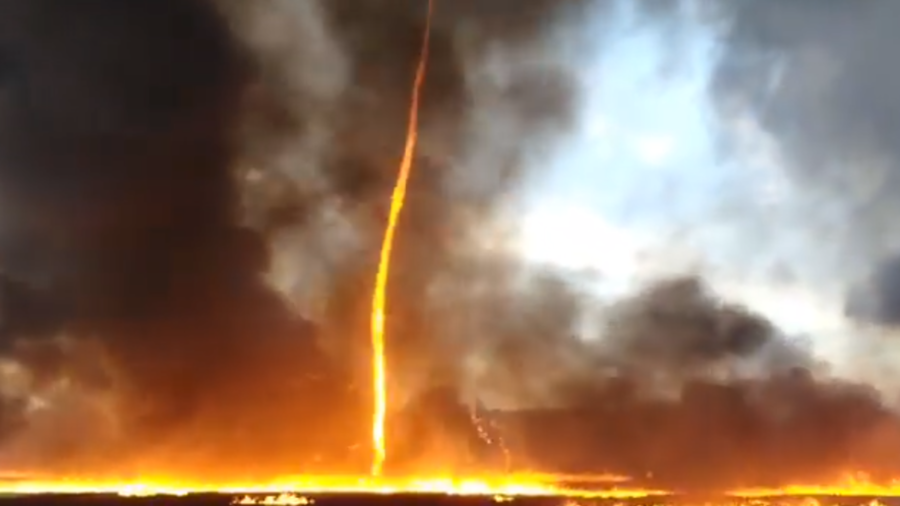NATURAL PHENOMENON
Fire Tornado

A fire tornado, also known as fire whirl, fire twister, or firenado is a whirlwind which is made up of ash or flame. Fire tornadoes begin with a swirl of smoke or wind. They usually occur when the turbulent wind conditions combine with the increasing heat from the fire to create a rotating eddy of air. The eddy then expands into a tornado-like vortex which sucks in combustible gases and burning debris.
Even though a fire whirl is informally known as a firenado, it is not frequently classified as a tornado since its vortex does not always stretch from the base of the cloud to the ground. Fire whirls are not classic tornadoes since their vorticity derives from the temperature-induced lifting and surface winds instead of the tornadic mesocyclone aloft. A mesocyclone is an air vortex which is created in a convective storm. The rising air revolves around a vertical axis in a similar direction as the low-pressure systems in the specified hemisphere.
Wildfires produce a majority of the most significant fire whirls. These fire tornadoes are created when the wildfire converges with a warm updraft of air. A wildfire can create numerous fire whirls of varying duration, size, and intensity. Fire whirls are generally a few feet wide and can attain a height of about 164 feet. The whirling winds of some fire tornadoes spin at roughly 99 miles per hour and achieve a maximum height of approximately 3,280 feet while persisting for over twenty minutes.
Firenadoes are very dangerous
and can cause a lot of destruction in a short amount of time because
they move fast and have a high temperature. They can uproot over tall
trees and buildings. The fire whirls help the firefighters determine the
ability of a wildfire to spread or even start a new fire as they can
carry burning tree barks. Burning debris can be blown from the wildfire
to other places by the strong winds.
Another example of a dangerous fire tornado was the supercell thunderstorm which was created by the fire cloud associated with a severe wildfire on January 18, 2003, in Canberra, Australia. The thunderstorm resulted in a huge firenado which the Fujita scale rated as EF3. The firenado and the related wildfire killed four people and injured 492.
A fire tornado, also known as fire whirl, fire twister, or firenado is a whirlwind which is made up of ash or flame. Fire tornadoes begin with a swirl of smoke or wind. They usually occur when the turbulent wind conditions combine with the increasing heat from the fire to create a rotating eddy of air. The eddy then expands into a tornado-like vortex which sucks in combustible gases and burning debris.
Even though a fire whirl is informally known as a firenado, it is not frequently classified as a tornado since its vortex does not always stretch from the base of the cloud to the ground. Fire whirls are not classic tornadoes since their vorticity derives from the temperature-induced lifting and surface winds instead of the tornadic mesocyclone aloft. A mesocyclone is an air vortex which is created in a convective storm. The rising air revolves around a vertical axis in a similar direction as the low-pressure systems in the specified hemisphere.
Formation of Fire Tornadoes
A fire tornado is made up of revolving air pockets and a burning core. The temperature of a fire whirl can reach a maximum of about 1,090°C. They are created when a firestorm or wildfire forms its wind system which is turned into a fire vortex resulting in the skinny and tall appearance of the firenado’s core.Wildfires produce a majority of the most significant fire whirls. These fire tornadoes are created when the wildfire converges with a warm updraft of air. A wildfire can create numerous fire whirls of varying duration, size, and intensity. Fire whirls are generally a few feet wide and can attain a height of about 164 feet. The whirling winds of some fire tornadoes spin at roughly 99 miles per hour and achieve a maximum height of approximately 3,280 feet while persisting for over twenty minutes.
Effects of Fire Tornadoes
Examples of Fire Tornadoes
Numerous fire tornadoes developed after lightning struck the Union Oil Company's storage facility on April 7, 1926, in San Luis Obispo, California resulting in the death of two people and significant structural damage. The firestorm burned for over five days producing numerous firenadoes. The incident resulted in large whirls which carried burning debris about 5 miles away.Another example of a dangerous fire tornado was the supercell thunderstorm which was created by the fire cloud associated with a severe wildfire on January 18, 2003, in Canberra, Australia. The thunderstorm resulted in a huge firenado which the Fujita scale rated as EF3. The firenado and the related wildfire killed four people and injured 492.


Komentar
Posting Komentar